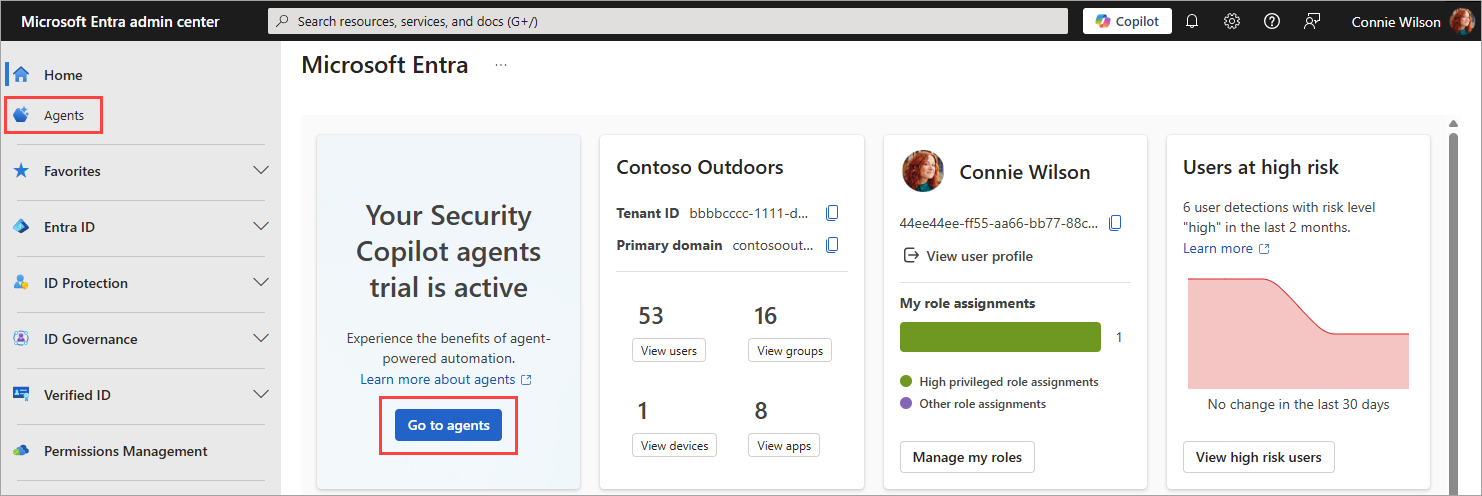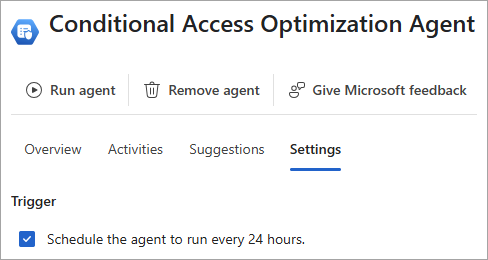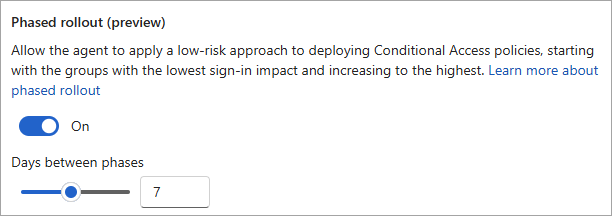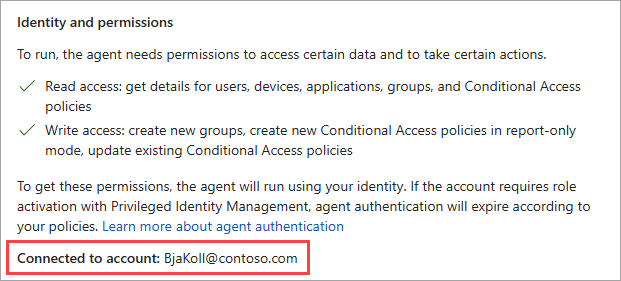Note
Access to this page requires authorization. You can try signing in or changing directories.
Access to this page requires authorization. You can try changing directories.
The Conditional Access optimization agent helps you ensure all users and applications are protected by Conditional Access policies. It recommends policies and changes based on best practices aligned with Zero Trust and Microsoft's learnings.
The Conditional Access optimization agent evaluates policies such as requiring multifactor authentication (MFA), enforcing device based controls (device compliance, app protection policies, and domain-joined devices), and blocking legacy authentication and device code flow. The agent also evaluates all existing enabled policies to propose potential consolidation of similar policies. When the agent identifies a suggestion, you can have the agent update the associated policy with one click-remediation.
Prerequisites
- You must have at least the Microsoft Entra ID P1 license.
- You must have available security compute units (SCU).
- On average, each agent run consumes less than one SCU.
- To activate the agent the first time, you need the Security Administrator or Global Administrator.
- You can assign Conditional Access Administrators with Security Copilot access, which gives your Conditional Access Administrators the ability to use the agent as well.
- For more information, see Assign Security Copilot access
- Global Reader and Security Reader roles can view the agent and any suggestions, but can't take any actions.
- Global Administrator, Security Administrator, and Conditional Access Administrator roles can view the agent and take action on the suggestions.
- Device-based controls require Microsoft Intune licenses.
- Review Privacy and data security in Microsoft Security Copilot
Limitations
- Avoid using an account to set up the agent that requires role activation with Privileged Identity Management (PIM). Using an account that doesn't have standing permissions might cause authentication failures for the agent.
- Once agents are started, they can't be stopped or paused. It might take a few minutes to run.
- For policy consolidation, each agent run only looks at four similar policy pairs.
- The agent currently runs as the user who enables it.
- We recommend running the agent from the Microsoft Entra admin center.
- Scanning is limited to a 24 hour period.
- Suggestions from the agent can't be customized or overridden.
- The agent can review up to 300 users and 150 applications in a single run.
How it works
The Conditional Access optimization agent scans your tenant for new users and applications from the last 24 hours and determines if Conditional Access policies are applicable. If the agent finds users or applications that aren't protected by Conditional Access policies, it provides suggested next steps, such as turning on or modifying a Conditional Access policy. You can review the suggestion, how the agent identified the solution, and what would be included in the policy.
Each time the agent runs, it takes the following steps. The initial scanning steps do not consume any SCUs.
- The agent scans all Conditional Access policies in your tenant.
- The agent checks for policy gaps and if any policies can be combined.
- The agent reviews previous suggestions so it won't suggest the same policy again.
If the agent identifies something that wasn't previously suggested, it takes the following steps. The agent action steps consume SCUs.
- The agent identifies a policy gap or a pair of policies that can be consolidated.
- The agent evaluates any custom instructions you provided.
- The agent creates a new policy in report-only mode or provides the suggestion to modify a policy, including any logic provided by the custom instructions.
Tip
Two policies can be consolidated if they differ by no more than two conditions or controls.
The policy suggestions identified by the agent include:
- Require MFA: The agent identifies users who aren't covered by a Conditional Access policy that requires MFA and can update the policy.
- Require device-based controls: The agent can enforce device-based controls, such as device compliance, app protection policies, and domain-joined devices.
- Block legacy authentication: User accounts with legacy authentication are blocked from signing in.
- Block device code flow: The agent looks for a policy blocking device code flow authentication.
- Risky users: The agent suggests a policy to require secure password change for high risk users. Requires Microsoft Entra ID P2 license.
- Risky sign-ins: The agent suggests a policy to require multifactor authentication for high risk sign-ins. Requires Microsoft Entra ID P2 license.
- Policy consolidation: The agent scans your policy and identifies overlapping settings. For example, if you have more than one policy that has the same grant controls, the agent suggests consolidating those policies into one.
Important
The agent doesn't make any changes to existing policies unless an administrator explicitly approves the suggestion.
All new policies suggested by the agent are created in report-only mode.
Getting started
Sign in to the Microsoft Entra admin center as at least a Security Administrator.
From the new home page, select Go to agents from the agent notification card.
- You can also select Agents from the left navigation menu.
Select View details on the Conditional Access Optimization Agent tile.
Select Start agent to begin your first run.
- Avoid using an account with a role activated through PIM.
- A message that says "The agent is starting its first run" appears in the upper-right corner.
- The first run might take a few minutes to complete.
When the agent overview page loads, any suggestions appear in the Recent suggestions box. If a suggestion was identified, you can review the policy, determine policy impact, and apply the changes if needed. For more information, see Review and approve Conditional Access agent suggestions.
Settings
Once the agent is enabled, you can adjust a few settings. You can access the settings from two places in the Microsoft Entra admin center:
- From Agents > Conditional Access optimization agent > Settings.
- From Conditional Access > select the Conditional Access optimization agent card under Policy summary > Settings.
Agent capabilities
By default, the Conditional Access optimization agent can create new policies in report-only mode. You can change this setting so that an administrator must approve the new policy before it's created. The policy is still created in report-only mode, but only after admin approval. After reviewing the policy impact, you can turn on the policy directly from the agent experience or from Conditional Access.
Trigger
The agent is configured to run every 24 hours based on when it's initially configured. You can run it at a specific time by toggling the Trigger setting off and then back on when you want it to run.
Microsoft Entra objects to monitor
Use the checkboxes under Microsoft Entra objects to monitor to specify what the agent should monitor when making policy recommendations. By default the agent looks for both new users and applications in your tenant over the previous 24 hour period.
Agent capabilities
By default, the Conditional Access optimization agent can create new policies in report-only mode. You can change this setting so that an administrator must approve the new policy before it's created. The policy is still created in report-only mode, but only after admin approval. After reviewing the policy impact, you can turn on the policy directly from the agent experience or from Conditional Access.
Phased rollout (preview)
When the agent creates a new policy in report-only mode, the policy is rolled out in phases, so you can control and monitor the effect of the new policy. Phased rollout is on by default.
You can change the number of days between each phase by either dragging the slider or entering a number of days in the text box. After making any changes, select the Save button at the bottom of the page. The number of days between each phase is the same for all phases. Make sure you're starting the phased rollout with enough time to monitor the impact before the next phase starts and so the rollout doesn't start on a weekend or holiday, in case you need to pause the rollout.
Identity and permissions
There are several key points to consider regarding the identity and permissions of the agent:
The agent runs under the identity and permissions of the user who enabled the agent in your tenant.
Avoid using an account that requires elevation through PIM for just-in-time elevation. If that user hasn't elevated to the appropriate role when the agent runs, the run fails.
The Security Administrator and Global Administrator roles have access to Security Copilot by default. You can assign Conditional Access Administrators with Security Copilot access. This authorization gives your Conditional Access Administrators the ability to use the agent as well. For more information, see Assign Security Copilot access.
The user who approves a suggestion to add users to a policy becomes an owner of a new group that adds the users to a policy.
The audit logs for actions taken by the agent are associated with the user who enabled the agent. You can find the name of the account that started the agent in the Identity and permissions section of the settings.
Custom instructions
You can tailor the policy to your needs using the optional Custom Instructions field. This setting allows you to provide a prompt to the agent as part of its execution. These instructions can be used to include or exclude specific users, groups, and roles. This field can also be used to add exceptions, such as to only apply the exception to specific types of policies, such as policies that require MFA.
You can also use the object ID for the users or groups you want to include in the custom instructions. Any specific object IDs included in the custom instructions are validated. Example custom instructions:
- "Exclude users in the "Break Glass" group from any policy that requires multifactor authentication."
- "Exclude user with Object ID dddddddd-3333-4444-5555-eeeeeeeeeeee from all policies"
For more information about how to use custom instructions, check out the following video.
Please note that some of the content in the video is subject to change as the agent is updated frequently.
Remove agent
If you no longer wish to use the Conditional Access optimization agent, select Remove agent from the top of the agent window. The existing data (agent activity, suggestions, and metrics) is removed but any policies created or updated based on the agent suggestions remain intact. Previously applied suggestions remain unchanged so you can continue to use the policies created or modified by the agent.
Providing feedback
Use the Give Microsoft feedback button at the top of the agent window to provide feedback to Microsoft about the agent.
FAQs
When should I use the Conditional Access optimization agent vs Copilot Chat?
Both features provide different insights into your Conditional Access policies. The following table provides a comparison of the two features:
| Scenario | Conditional Access Optimization Agent | Copilot Chat |
|---|---|---|
| Generic Scenarios | ||
| Utilize tenant-specific configuration | ✅ | |
| Advanced reasoning | ✅ | |
| On-demand insights | ✅ | |
| Interactive troubleshooting | ✅ | |
| Continuous policy assessment | ✅ | |
| Automated improvement suggestions | ✅ | |
| Get guidance on CA best practices and configuration | ✅ | ✅ |
| Specific Scenarios | ||
| Identify unprotected users or applications proactively | ✅ | |
| Enforce MFA and other baseline controls for all users | ✅ | |
| Continuous monitoring and optimization of CA policies | ✅ | |
| One-click policy changes | ✅ | |
| Review existing CA policies and assignments (Do policies apply to Alice?) | ✅ | ✅ |
| Troubleshoot a user's access (Why was Alice prompted for MFA?) | ✅ |
I activated the agent but see "Fail" in the activity status. What's happening?
It's possible that the agent was enabled with an account that requires role activation with Privileged Identity Management (PIM). So when the agent attempted to run, it failed because the account didn't have the required permissions at that time. You're prompted to reauthenticate if PIM permission expired.
You can resolve this issue by removing the agent, then enabling the agent again with a user account that has standing permissions for Security Copilot access. For more information, see Assign Security Copilot access.






